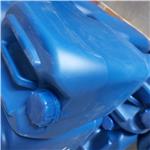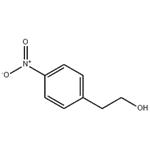- 4-Nitrobenzeneethanol
-

- $10.00 / 1KG
-
2025-10-21
- CAS:100-27-6
- Min. Order: 1KG
- Purity: 99%
- Supply Ability: 10 mt
- 4-Nitrobenzeneethanol
-

- $100.00 / 1KG
-
2025-09-25
- CAS:100-27-6
- Min. Order: 1KG
- Purity: 99%
- Supply Ability: g-kg-tons, free sample is available
|
| | 4-Nitrobenzeneethanol Basic information |
| Product Name: | 4-Nitrobenzeneethanol | | Synonyms: | p-Nitrophenylethyl alcohol;4-Nitrophenethyl Alcohol
2-(4-Nitrophenyl)ethyl Alcohol;Benzeneethanol,4-nitro-;4-Nitrobenzeneethanol, 99%, 99%;4-Nitrophenethyl alcohol,2-(4-Nitrophenyl)ethanol;2-(4-Nitrophenyl)ethan-1-ol, 4-(2-Hydroxyethyl)nitrobenzene;2-(4-Nitrophenyl)ethanol, 99+%;SS-P-NITROPHENYLETHANOL | | CAS: | 100-27-6 | | MF: | C8H9NO3 | | MW: | 167.16 | | EINECS: | 202-835-8 | | Product Categories: | Aromatic alcohols and diols | | Mol File: | 100-27-6.mol |  |
| | 4-Nitrobenzeneethanol Chemical Properties |
| Melting point | 59-62 °C(lit.) | | Boiling point | 177 °C16 mm Hg(lit.) | | density | 1.2917 (rough estimate) | | refractive index | 1.5570 (estimate) | | storage temp. | Sealed in dry,Room Temperature | | solubility | Chloroform, Methanol (Slightly) | | form | Solid | | pka | 14.57±0.10(Predicted) | | color | White to Light Brown | | Water Solubility | <0.01 g/100 mL at 18 ºC | | BRN | 1866148 | | Stability: | Stable. Combustible. Incompatible with strong oxidizing agents, strong bases. | | CAS DataBase Reference | 100-27-6(CAS DataBase Reference) | | NIST Chemistry Reference | Benzeneethanol, 4-nitro-(100-27-6) | | EPA Substance Registry System | 4-Nitrobenzeneethanol (100-27-6) |
| | 4-Nitrobenzeneethanol Usage And Synthesis |
| Chemical Properties | yellow to orange crystalline powder | | Uses | 4-Nitro-benzeneethanol is a useful synthetic intermediate. It can be used to synthesize N-phenylethylindole carboxamides as SAR study of allosteric modulators of CB1 receptor. It can also be used to prepare 2-aza-2''-deoxyinosine-containing oligodeoxyribonucleotide duplexes. | | Synthesis Reference(s) | The Journal of Organic Chemistry, 38, p. 2786, 1973 DOI: 10.1021/jo00956a011 | | General Description | Yellow needles (from aqueous methanol) or orange solid. | | Air & Water Reactions | Insoluble in water. | | Reactivity Profile | A nitrated alcohol. Flammable and/or toxic gases are generated by the combination of alcohols with alkali metals, nitrides, and strong reducing agents. They react with oxoacids and carboxylic acids to form esters plus water. Oxidizing agents convert them to aldehydes or ketones. Alcohols exhibit both weak acid and weak base behavior. They may initiate the polymerization of isocyanates and epoxides. | | Health Hazard | SYMPTOMS: Structurally similar chemicals may cause methemoglobinemia. | | Fire Hazard | Flash point data for 4-Nitrobenzeneethanol are not available; however, 4-Nitrobenzeneethanol is probably combustible. | | Synthesis | (1) Dissolve p-nitrophenylacetic acid in ether and heat under nitrogen protection to 50°C. Slowly add lithium aluminium hydride (mass ratio of lithium aluminium hydride to p-nitrophenylacetic acid 1:2) and make sure that the mixture is homogeneous. Subsequently, water was added dropwise (the mass ratio of the amount of water added dropwise to lithium aluminum hydride was 1:1) and the reaction continued to be stirred for 3 hours. Upon completion of the reaction, the reaction mixture was cooled to 0°C, and a 12% sodium hydroxide solution (the mass ratio of sodium hydroxide to lithium aluminum hydride was 3:2) and water (the mass ratio of water to lithium aluminum hydride for the second addition was 5:2) were slowly added. After standing for 20 minutes, it was gradually warmed to room temperature and dried by adding anhydrous MgSO4. After stirring for 30 minutes, filter and distill to remove the solvent in the filtrate to obtain p-nitrophenylethanol. (2) Dissolve p-nitrophenyl ethanol in ethanol and add catalyst (a mixture of CeO2, MnO and ZnO in the ratio of 1:2:5; the mass ratio of p-nitrophenyl ethanol to catalyst was 3:167). The reaction system was warmed up to 80°C under nitrogen atmosphere. hydrogen was introduced at atmospheric pressure and the reaction was carried out for 3 h. The reaction was carried out at atmospheric pressure and the reaction was carried out at atmospheric pressure and the reaction was carried out at atmospheric pressure. After completion of the reaction, it was cooled to room temperature and the catalyst was removed by filtration. Ethanol was removed by distillation and the resulting solid was purified by recrystallization to give p-aminophenethyl alcohol. | | References | [1] Patent: CN108033888, 2018, A. Location in patent: Paragraph 0019-0057
[2] European Journal of Organic Chemistry, 2011, # 17, p. 3178 - 3183
[3] Journal of Medicinal Chemistry, 1990, vol. 33, # 11, p. 3008 - 3014
[4] Journal of the Chemical Society, Perkin Transactions 1: Organic and Bio-Organic Chemistry (1972-1999), 1992, # 1, p. 109 - 114
[5] Patent: WO2004/29066, 2004, A2. Location in patent: Page/Page column 302 |
| | 4-Nitrobenzeneethanol Preparation Products And Raw materials |
|